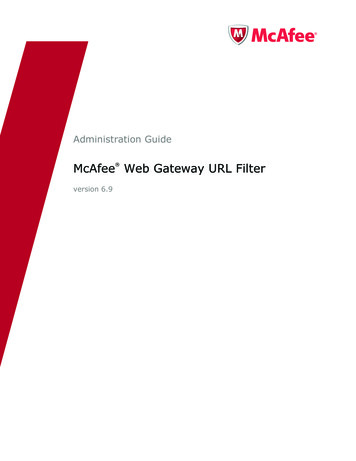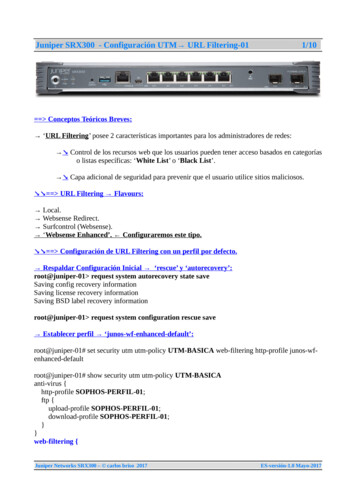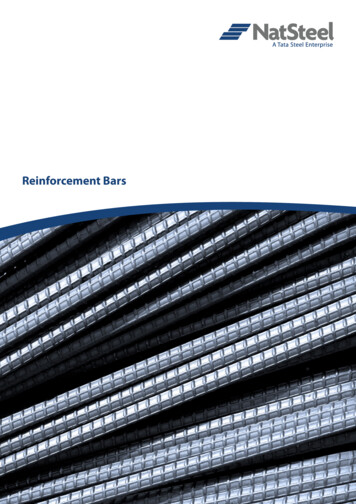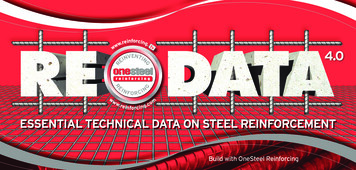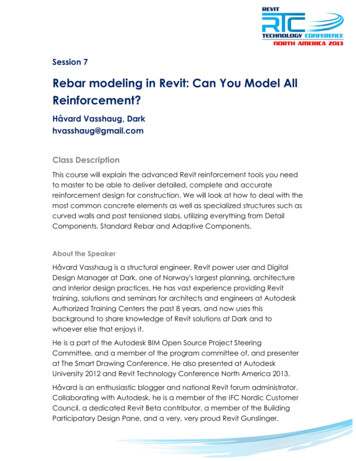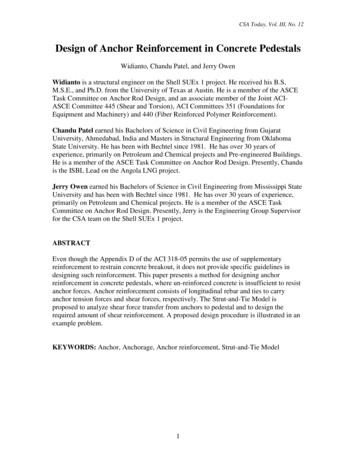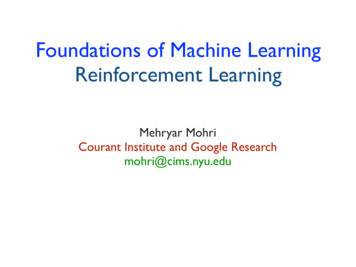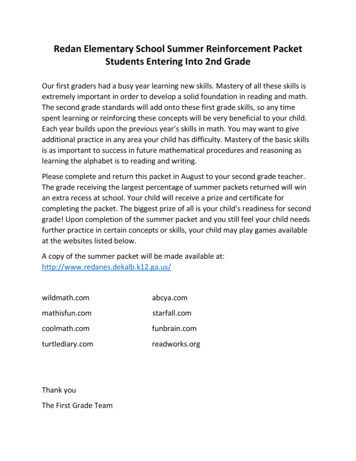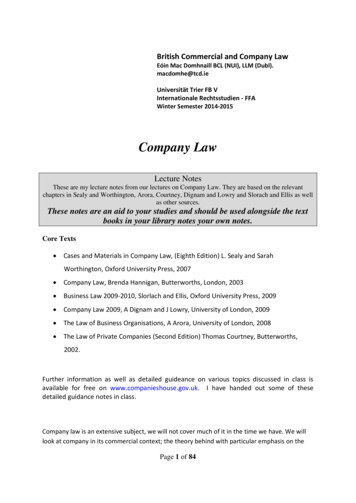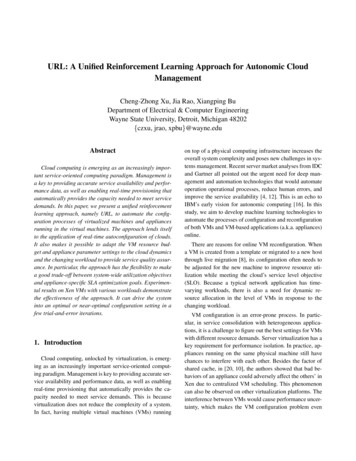
Transcription
URL: A Unified Reinforcement Learning Approach for Autonomic CloudManagementCheng-Zhong Xu, Jia Rao, Xiangping BuDepartment of Electrical & Computer EngineeringWayne State University, Detroit, Michigan 48202{czxu, jrao, xpbu}@wayne.eduAbstractCloud computing is emerging as an increasingly important service-oriented computing paradigm. Management isa key to providing accurate service availability and performance data, as well as enabling real-time provisioning thatautomatically provides the capacity needed to meet servicedemands. In this paper, we present a unified reinforcementlearning approach, namely URL, to automate the configuration processes of virtualized machines and appliancesrunning in the virtual machines. The approach lends itselfto the application of real-time autoconfiguration of clouds.It also makes it possible to adapt the VM resource budget and appliance parameter settings to the cloud dynamicsand the changing workload to provide service quality assurance. In particular, the approach has the flexibility to makea good trade-off between system-wide utilization objectivesand appliance-specific SLA optimization goals. Experimental results on Xen VMs with various workloads demonstratethe effectiveness of the approach. It can drive the systeminto an optimal or near-optimal configuration setting in afew trial-and-error iterations.1. IntroductionCloud computing, unlocked by virtualization, is emerging as an increasingly important service-oriented computing paradigm. Management is key to providing accurate service availability and performance data, as well as enablingreal-time provisioning that automatically provides the capacity needed to meet service demands. This is becausevirtualization does not reduce the complexity of a system.In fact, having multiple virtual machines (VMs) runningon top of a physical computing infrastructure increases theoverall system complexity and poses new challenges in systems management. Recent server market analyses from IDCand Gartner all pointed out the urgent need for deep management and automation technologies that would automateoperation operational processes, reduce human errors, andimprove the service availability [4, 12]. This is an echo toIBM’s early vision for autonomic computing [16]. In thisstudy, we aim to develop machine learning technologies toautomate the processes of configuration and reconfigurationof both VMs and VM-based applications (a.k.a. appliances)online.There are reasons for online VM reconfiguration. Whena VM is created from a template or migrated to a new hostthrough live migration [8], its configuration often needs tobe adjusted for the new machine to improve resource utilization while meeting the cloud’s service level objective(SLO). Because a typical network application has timevarying workloads, there is also a need for dynamic resource allocation in the level of VMs in response to thechanging workload.VM configuration is an error-prone process. In particular, in service consolidation with heterogeneous applications, it is a challenge to figure out the best settings for VMswith different resource demands. Server virtualization has akey requirement for performance isolation. In practice, appliances running on the same physical machine still havechances to interfere with each other. Besides the factor ofshared cache, in [20, 10], the authors showed that bad behaviors of an appliance could adversely affect the others’ inXen due to centralized VM scheduling. This phenomenoncan also be observed on other virtualization platforms. Theinterference between VMs would cause performance uncertainty, which makes the VM configuration problem even
bility, they often restricted themselves to one or two controlknobs: MaxClient parameter in Apache server [18], CPUshares in web server [1, 19, 31, 32, 35], network-I/O bandwidth in streaming server [39], for examples. In [21],the authors applied adaptive control to autoconfiguration of multi-tier web systems on VM-based dynamicenvironments. But only results from an integral controller (often with limited stability) were reported; andthe controllers for different tiers were tuned independently.harder.In addition to the VM capacity, application performanceis also crucially dependent on its own configuration. It isknown that web appliances like Apache and Tomcat often contain more than a hundred parameters to configurewhen they are deployed. Incorrect settings of the parameters would lead to performance degradation to a large extent. Traditionally, a web system is configured manually,based on operator’s experience. Like VM configuration, thisis a non-trivial and error-prone task too. Moreover, in multicomponent systems like multi-tier websites, the interactionbetween the components makes performance tuning of theparameters harder. A misconfiguration in one tier may causemisconfiguration in the others. Performance optimization ofindividual components does not necessarily lead to overall system performance improvement [7]. In [38], the authors demonstrated that in a cluster-based Internet service,when the application server tier was updated with more orless servers, the entire system configuration should be modified to adjust itself to this evolution.In this paper, we present a unified reinforcement learning approach, namely URL, for autoconfiguration of VMsand appliances. Reinforcement learning (RL) is a process oflearning by interactions with dynamic environment, whichgenerates optimal control (or action) policies on a given environment state. Unlike adaptive control, RL does not require a model of either the system or the environment dynamics. Also, RL is able to generate policies optimizing along-term goal based on immediate rewards of actions. Recent studies demonstrated the feasibility of RL in a wide variety of applications, including the design of computer systems; see [3, 13, 28, 30, 29] for examples. There were fewreports so far on the use of RL in VM-level resource management or virtual appliances. Designing a RL-based controller to automate the configuration processes poses uniquechallenges to be discussed in Section 2.Server virtualization introduces an extra layer of indirection in resource management. The need for dynamic VMconfiguration/reconfiguration adds one more dimension ofchallenge to appliance configuration. In particular, the configuration operation must be performed on-line and automatically.Because each machine contains a large number of configurable parameters, such as cpu time, memory, and network bandwidth, and the VMs on the same host mayinterfere with each other, the large design space renders traditional optimization and feedback control approaches impractical in real-time resource configuration. The RLmethodology finds a good application in online autoconfiguration. The unified RL (URL) approach is applicable forautoconfiguration of both VMs and multi-tier web appliances. It is able to adapt the VM resource budget and appliance parameter settings in a coordinated way to thechanging workload to the provisioning of service quality assurance. In particular, the approach has the flexibilityto make a good tradeoff between system-wide utilization objectives and appliance-specific SLA optimizationsin different VMs.In general, the configuration problem is to find an optimal combination of parameter settings with respect to aperformance objective function. There were recent studies on the use of classical combinatorial optimization approaches like hill-climbing and Simplex to automate thetuning process of web applications in a static environment;see [34, 37, 7, 38] for examples. In VM-based dynamic platforms, configurable parameters such as CPU time and memory size are not independent; application parameters oftenhave a concave downward (rather than monotonic) effecton performance. These complicate the optimization problem. The time complexity of the classical optimization approaches prevents them from being applied frequently atrun-time for online reconfiguration of the parameters.There were other studies on the use of feedback controlapproaches to adaptively reconfiguring VMs [21], web applications [18], and dynamic resource allocation in staticand dynamic environments. Traditional feedback control approaches to QoS-aware resource managementachieved the goal of service quality assurance to some extent; see [35] and the references therein. But for controlla-The rest of this paper is organized as follows. Section 2presents scenarios to show the challenges in configurationmanagement in dynamic environments. Section 3 presentsbasic ideas of the RL approach and its application in autoconfiguration. Enhancement of the approach with modelbased initialization policies is given in Section 4. Section 52
and Section 6 present the evaluation methodology, settings,and experimental results. Related work is discussed in Section 7. Section 8 concludes the paper with remarks on limitations of the approach and possible future work.timeout, minSpareThreads, maxSpareThreadsin Tomcast server. We assumed the default settings forMySQL parameters.We tested the application performance using TPC-Wbenchmark on a cluster of Linux servers, each with twoquad-core Intel Xeon processors and eight GB memory. Itis expected that each workload has its preferred configuration, under which the system would yield best performancein terms of response time and throughput. We tuned the application configuration manually for each workload. Figure 1(a) shows the performance under different workloadmixes. The configuration in each group of bars was besttuned for ordering, shopping, and browsing workload, respectively. From the figure, we can see that there is no singleconfiguration suitable for all kinds of workloads. In particular, the best configuration for shopping or browsing mixesled to extremely poor performance under ordering workload. The first objective of this study is to develop an RLbased autoconfiguration approach to adapt the applicationconfiguration to the changing workload.2. Challenges of AutoconfigurationIn this section, we use Xen virtualization platform andweb applications as examples to illustrate the challenges indetermining good configurations of VMs and appliances inclouds. Similar challenging issues exist in VMWare, VirtualBox and other virtualization platforms.2.1. Match Configuration to Changing WorkloadIt is known that performance of a multi-tier web system heavily depends on the characteristics of its workload.Different types of workload have requirements for differentamount of resources of different types. TPC-W benchmark,and its successor TPC-APP (www.tpc.org), defines threetypes of workload: ordering, shopping, and browsing, representing three traffic mixes. Because processing of a requestinvolves multiple system components in different tiers, ourpast studies showed that saturation of the system in the processing of one type of requests does not necessarily mean itcannot handle the others [24]. Bottleneck may also shift dynamically from tier to tier. Application configuration mustmatch the need of current workload to achieve a good performance.2.2. Match Configuration to Virtual Machine DynamicsFor a web system hosted on VMs, its throughput iscapped by the VMs configurations. Recall that in a cloudcomputing environment, VMs may need to be reconfiguredon-demand in response to the change of underlying computing resources (addition/removal of nodes), fault tolerance,service live migration, and other purposes. Any changeof the VM configuration would render the early carefullytuned web system configuration obsolete. Real-time reconfiguration is needed.For instance, MaxClients is one of the key performance parameters in Apache, which sets the maximumnumber of requests to be served simultaneously. A too smallsetting would lead to low resource utilization, and a highvalue may drive the system into an overloaded condition.How to set this parameter should be determined by the resource demands, the traffic, and resource capacity of itsVM. For a VM resource cap, a configuration of this parameter for heavy load may lead to poor performance under lightly loaded conditions.In the following, we continue to use the MaxClientsparameter to show the challenge due to the VM dynamics.In this experiment, we assume an input of fixed workload,but change the VM resource capacity dynamically. We defined three levels of resource capacity: Level-1 (4 virtualCPUs and 4GB memory), Level-2 (3 virtual CPUs and 3GBmemory), and Level-3 (2 virtual CPUs and 2GB memory).Figure 1(b) shows the impact of MaxClients setting under different VM configurations. We can observe that eachVM configuration has its own preferred MaxClients setting, leading to the minimum response time. To our surprise, as the VM capacity increases, the best setting ofMaxClients goes down instead of going up. A possible reason is that because with the VM becoming more andmore powerful, it can complete a request in a shorter time.To show the effect of overall configuration, we set upa three-tier Apache/Tomcat/MySQL website, each running on a virtual machine. Recall Apache and Tomcat eachhas more than a hundred configuration parameters. We restricted our attention to eight performance-critical parameters from different tiers: MaxClients, Keepalivetimeout, MinSpareServers, MaxSpareServersin Apache server and MaxThreads, Session3
10000010000100level1 best configurationlevel2 best configurationlevel3 best configuration10000Response Time(ms)100010000level 1level 2level 3Response Time(ms)Response Time(ms)ordering best configurationshopping best configurationbrowsing best configuration1000100100010010Level 110orderingshopping(a) Tuned for workloadsbrowsingLevel 2Number of Clients(b) Effect of MaxClientsLevel 310Level 1Level 2Level 3(c) Tuned for VM resourcesFigure 1: Performance of applications under different settings and different VM configurations.(dom0) is a privileged VM which manages other guest doAs a result, the number of concurrent requests will decrease.mains (or VMs) and executes resource allocation policies.The measured response time of a request includes its queuXen provides a control interface in the driver domain toing time and processing time. The MaxClients paramemanage the available resources to each VM, including theter controls the balance between these two factors. A largefollowing three performance-critical configurable paramevalue would help reduce the queueing time, but at the costters: number of virtual CPUs (vcpu), schedule credit(time),of processing time because of the increased level of concurand memory size (mem).rency. The non-linear relationship between the best choiceof MaxClients and VM configuration complicates theIn Xen’s implementation, privileged instructions andconfiguration problem of web applications.memory writes are trapped and validated by the hypervisor; I/O interrupt is handled by the VMM and data is transfered to VMs in cooperation with dom0. The involvementof the centralized virtualization layer in guest program execution can also be found in other platforms, such asVMware and Hyper-V. Thus, bad behavior of one VM mayadversely affect the performance of other VMs by depriving the hypervisor and driver domain resources. In [10], theauthors showed that for I/O intensive applications, by setting a fixed CPU share, the credit scheduler does not account for the work done for individual VM in the driverdomain. Taking memory and virtual CPU into consideration, the involvement of dom0 and hypervisor in VMexecution aggravates the uncertainties in resource to performance mapping. For example, allocating more resource to one VM may result in a performance degradationdue to the other VMs’ impediment caused by resource deallocation.In addition to MaxClients, we tested the effects ofother parameters under different VM configurations. Weobserved similar nonlinear relationships between the bestsettings of the parameters and the VM configuration. Figure 1(c) shows no single configuration is best for all VMconfigurations. In particular, the performance under Level2 configuration may even deliver better performance underLevel-1 platform. The second objective of this study is toextend the RL-based autoconfiguration approach to adaptthe application configuration to VM dynamics.2.3. Interference of VMs and Heterogeneous AppliancesServer virtualization allows multiple VMs to share computing resources in the same pool. Their performance ishard to be isolated. VM interference poses one more challenge to the autoconfiguration problem. VMs of a physicalnode are not necessarily homogeneous, running different instances of the same application. VM heterogeneity makesthe configuration problem even harder.We created three VMs on a 2-socket quad-core Xeonserver, running TPC-W (e-Commerce), TPC-C (onlinetransaction processing, www.tpc.org), and vely. Their initial configurations in the form of (vcpu,time, mem) were (2, 256, 512MB) in TPC-W, (1, 256,1.5GB) in TPC-C, and (2, 512, 512MB) in SPECweb.We defined four workload scenarios for the three applications, as shown in Table 1 of Section 6. Figure 2(a) showsthe applications performance under different workload scenarios under fixed VM configurations. We observed thatthe workload change in TPC-W from browsing to ordering mix (workload-l) boosted the performance ofXen virtualization relies on a VM monitor (VMM) tomanage the underlying computing resources. It is the lowestlevel software abstraction, consisting of two components: ahypervisor and a driver domain. The hypervisor providesthe guest OS, also called a guest domain in Xen, the illusion of occupying the actual hardware devices, by performing functions such as CPU scheduling, memory mapping and I/O handling for guest domains. The driver domain4
of Q(s, a), given sufficiently large number of samples. Qlearning is a temporal-difference (TD) method, which updates Q(s, a) each time when a sample is collected:SPECweb at the cost of TPC-C; the workload reduction in SPECweb (workload-3) led to significant performance degradation of TPC-C. Uncertainties in otherworkload change scenarios can also be observed. Figure 2(b) shows the normalized application performance dueto VM configuration changes. Config-1 moves 1GB memory from TPC-C to SPECweb; Config-2 reduces the virtualCPU of TPC-W from 2 to 1; Config-3 moved 256 schedule credits from SPECweb to TPC-C. There are uncertainties of performance changes. In particular, in the case ofconfig-2, the configuration change of TPC-W from 2 virtual CPUs to 1 unexpectedly causes a big drop of the TPC-Cperformance. The third objective of this study is to develop approaches for coordinated autoconfiguration of bothVMs and appliances to adapt them to both cloud dynamics and workload uncertainty.Q(st , at ) Q(st , at ) α [rt 1 γ Q(st 1 , at 1 ) Q(st , at )],(2)where α is the learning rate and γ is the discount factor.The VM configuration task fits within the agentenvironment framework. Consider multiple VMs to beconfigured on one or more physical machines. The environment comprises the VMs and the agent is a VM controller, namely VM-Agent. The agent keeps monitoringthe performance of each VM and adapt their configurations to the dynamics of the environment online. Eachtime when the agent changes a VM configuration, it receives performance feedback, either reward or penalty. After sufficient interactions, the agent would obtain goodestimations of the Q-value of each state-action pair. Starting from any initial configuration, the agent is able todrive the VMs to optimal configurations in terms of system’s throughput, utilization, or any other application-levelutility functions. In the case that the VMs are running different components of a single application (e.g. multi-tierwebsite), the objective can also be a service level objective (SLO), defined in the application’s
In addition to the VM capacity, application performance is also crucially dependent on its own configuration. It is known that web appliances like Apache and Tomcat of-ten contain more than a hundred parameters to configure when they are deployed. Incorrect settings of the parame-ters
